Laser scanning assembly having an improved scan angle-multiplication factor
a laser scanning and multiplication factor technology, applied in the field of optical scanning devices, can solve the problems of loss of light collection ability, difficult to avoid, and the configuration of laser scanning does not amplify the scan angle multiplication factor of the pair of rotating mirrors beyond. achieve the effect of uniform light collection
- Summary
- Abstract
- Description
- Claims
- Application Information
AI Technical Summary
Benefits of technology
Problems solved by technology
Method used
Image
Examples
Embodiment Construction
[0025]Referring to the figures in the accompanying drawings, the various illustrative embodiments of the present invention will be described in greater detail, wherein like elements will be indicated using like reference numerals.
[0026]In general, the laser scanning assembly of the present disclosure can be embodied in diverse kinds of optical scanning systems. For purposes of illustration, FIG. 1 shows the laser scanning assembly embodied in a point of sale (POS) laser scanning system 1. It is understood, however, that the laser scanning assembly 10, 10′ can be installed in other types of laser scanning systems, including hand-supportable, POS-projection and industrial type laser scanning systems.
First Laser Scanning System Employing the Laser Scanning Assembly of the First Illustrative Embodiment
[0027]FIGS. 2 and 3 show the laser scanning assembly of the first illustrative embodiment 10 configured in combination with a first cluster of stationary mirrors 11, disposed within a seco...
PUM
 Login to View More
Login to View More Abstract
Description
Claims
Application Information
 Login to View More
Login to View More - R&D
- Intellectual Property
- Life Sciences
- Materials
- Tech Scout
- Unparalleled Data Quality
- Higher Quality Content
- 60% Fewer Hallucinations
Browse by: Latest US Patents, China's latest patents, Technical Efficacy Thesaurus, Application Domain, Technology Topic, Popular Technical Reports.
© 2025 PatSnap. All rights reserved.Legal|Privacy policy|Modern Slavery Act Transparency Statement|Sitemap|About US| Contact US: help@patsnap.com



